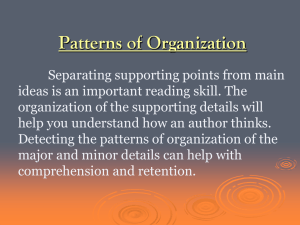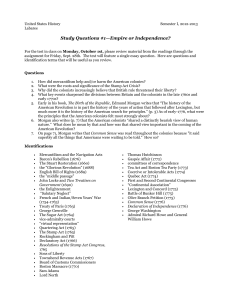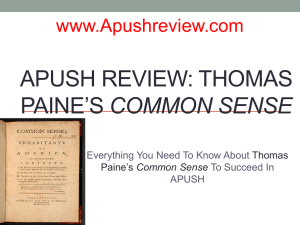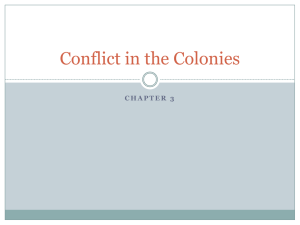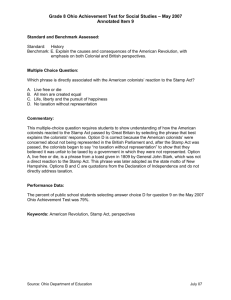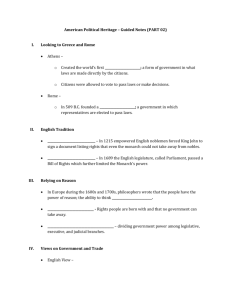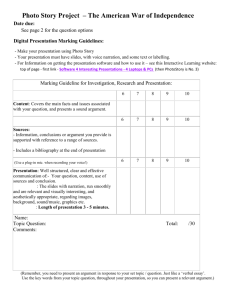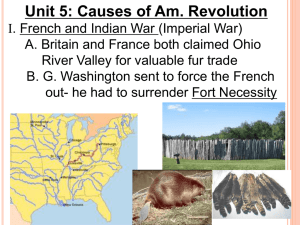patterns-of-organization
advertisement
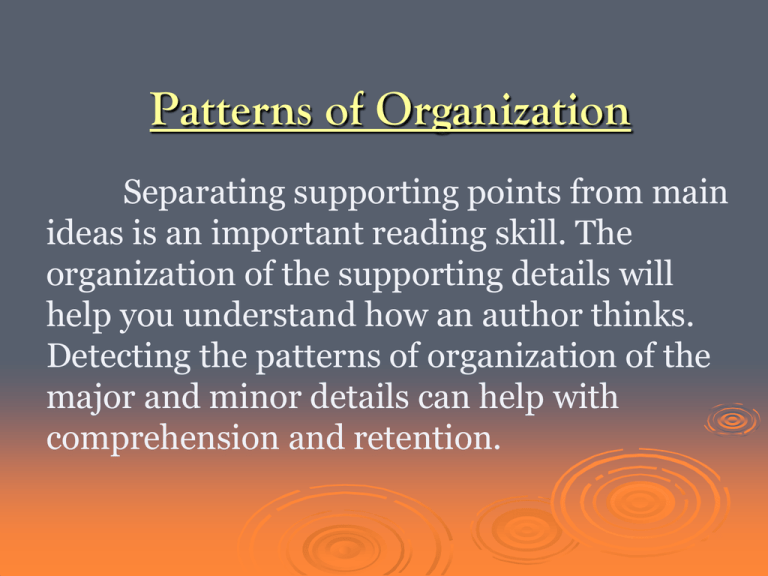
Patterns of Organization Separating supporting points from main ideas is an important reading skill. The organization of the supporting details will help you understand how an author thinks. Detecting the patterns of organization of the major and minor details can help with comprehension and retention. The main idea… The thesis or main idea is usually a good predictor of the organization of an essay or paragraph. Main Idea Text Topic Sentence Paragraph Thesis Essay Theme Story, novel, play Signal Words Signal words, also known as transitions, are words which indicate the relationship between ideas, and the organization of the details. Time Order / Sequence Pattern 1. Items are listed in the order in which they occurred or in a specifically planned order in which they must develop. In this case, the order is important and changing it would change the meaning. 2. specific order required: chronological, WHAT sequential, spatial, etc. HOW The colonists’ war for independence was marked by four major events. First, the battle of Lexington and Concord occurred when the British clashed with the colonists on April 19, 1775. Second, The British drove the Americans from their positions at Bunker Hill on June 17, 1775. Third, General Washington gained a victory at Princeton on January 3, 1777. Fourth, on October 19, 1781, the British surrendered in the war’s last major battle. These four major events were deciding factors in the colonists’ war for independence. SIGNAL WORDS of Time Order / Sequence before how when subsequently ultimately immediately initially presently first, second, etc. later finally then previously next meanwhile after formerly last 4 Major Events in Colonists War for Independence April 19,1775 Clash at Lexington and Concord June 17, 1775 American victory at Bunker Hill Jan. 3, 1777 Washington’s victory at Princeton Oct. 19, 1781 British surrender at Yorktown The COMPARE / CONTRAST Pattern Items are related by the comparisons (similarities) that are made or by the contrasts (differences) that are presented. > two or more persons, places, things WHAT During the War for Independence, the British and American armies were very different. The British army was composed of professional soldiers, while the American army was made up of civilians who knew little about military strategy and were untrained for warfare. Although the British were skilled soldiers, the colonists had one advantage- they were more familiar with the terrain than their enemy. The English used cash and credit to outfit their army with uniforms, arms, and ammunition, but the American troops usually supplied their own arms and often wore only the clothing of the day, because there was no official government with tax or money or credit. All of these facts demonstrate how different the British and American armies were when the fought in the War for Independence. Signal Words: Compare/Contrast COMPARE as similarly at the same time like as well as in comparison both all by the same token furthermore CONTRAST but on the other hand in spite of conversely despite however nonetheless on the contrary rather nevertheless notwithstanding though yet regardless whereas although in contrast unlike for all that even though The Cause / Effect Pattern This pattern describes or discusses an event or action that is caused by another event or action. WHAT happened? (effect) WHY did it happen? (cause) Why In order to refill the treasury depleted by its many wars, What the English Parliament passed the Stamp Act in 1765. It required colonists to buy stamps to be placed on legal papers, diplomas and newspapers. Signal Words- CAUSE / EFFECT CAUSE EFFECT reason due to on account of leads to led to since because outcome result as a result therefore thus consequently hence for this reason finally CAUSES EFFECTS war debts - drain on Treasury Stamp act Colonists’ protests “taxation without representation” repeal of Stamp Act Problem-Solution Pattern The text presents a significant problem and explains it in detail. Then, a possible solution is proposed. Sometimes, only the problem is presented because there is no solution. Readings answer the questions: “What is the problem?” “What is a possible solution?” Signal Words: Problem and Solution o problem, need, difficulty, dilemma, enigma, challenge, issue o answer, propose, suggest, indicate, solve, resolve, improve, plan, respond to a need Thesis example: Since pollution has a detrimental impact on modern living standards, a key solution is increased recycling of waste products. Definition / Classification Pattern In this pattern, a word or concept is introduced then explained or described. An example of its usage could follow. The pattern is very close to illustration or description. Readings answer the question: “What is it?” Signal Words: Definition / Classification define as, is, known, the term means, is stated as, is used to mean… for example, to illustrate, for instance, such as, specifically… i.e., e.g. Thesis Example: Ragtime music is a term that identifies one style of music that developed at the turn of the twentieth century. Played primarily by piano, the “Rocking Horse Rag” is an excellent short sample of ragtime. Description Pattern Description is like listing; the characters that make up a description are no more than a simple listing of details. Frequently in textbook reading an entire paragraph is devoted to defining a complex term or idea. The information listed may be items, facts, reasons, examples, features or characteristics. Signal Words: Description in addition another for example several various many numerous some others WHAT furthermore finally too also Many modern people are turning themselves into social victims. One example is a Tennessee woman who is suing McDonald’s because she was badly burned on the chin by a hot pickle in her hamburger. A Canadian woman is another example. She wants to ban the South Park television show because her son Kenny is victimized by the show’s Kenny character, who is killed in each episode. Adapted from: http://www.montgomerycollege.edu/~steuben/Patterns%20of%20Organization.pdf www.teachershavemerit.org/NCEA/Informational%20Writing%20.ppt
